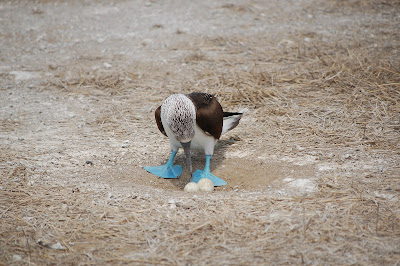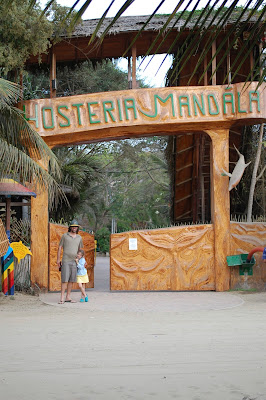From Puerto López, we hopped a boat to Isla de la Plata, AKA "the poor man's Galápagos." We zoomed up the beach, jumped out of the van, put our shoes in the shoe-bag, and waded into the surf where the first mate was holding the boat. The boat was full of French people who'd been waiting for us. We were late because we missed the memo -- our tour was to shove off an hour earlier than planned. Our guide had showed up at the hosteleria while we were just getting breakfast, so we had to jump into hurry-up mode. It isn't easy to get six people moving, especially when two of them are under eight.
So we had this boatload of surly Frenchies, most of whom didn't speak English or Spanish. Their guide had to give Winston a dressing down, I'm guessing to save face for the Europeans, who had gone at least half an hour without a cigarette. It seemed futile to say it wasn't our fault, so we just hunkered in and smiled. (Okay, I muttered some choice words and then just got over it.)
We were quickly underway, though the boat did have to stop for a stamp from the floating harbormaster, who actually never answered the door. Already running late to catch another boatload of French people, our captain was quickly fed up and made the executive decision to forgo the day's stamp. After that, we were slamming through the swells, many of which were taller than our boat.
Oakes didn't fare so well, and having packed up for the day so quickly, Kerry could not locate the dramamine she thought she might or might not have remembered. Sylvia, on the other hand, yelled "yee-ha" every time we hit a big wave. The Frenchies snapped a bazillion pictures of each other, and when we caught the other boat, they waved and snapped another bazillion pictures of waving at the boat.
After a good fifty minutes, we could finally make out the shape of the island. Oakes looked a little green, but quickly sprung to life when we came up in the calm lee of rocky land. Most of the rocks had a white sheen from the guano, and we could see thousands of frigate birds on their nests. You could see how dry the whole island was, covered with scrubby brush and rising a couple of hundred feet out of the Pacific.
Finally we pulled up to a gorgeous little beach, at about the half point of the island, and where there was a little park station. Isla de la Plata is actually a part of Machalilla National Park which stretches up and into the humid forest inland. We repeated the wading ritual in reverse, and recovered our shoes from the shoe-bag which the first mate had upended on the beach. Most of the Frenchies hustled ashore and lit up smokes. We found Winston, and at a map of the trails, he abruptly began our tour of the island.
Did we want to take the long or the short tour? I'm pretty sure that we said short, but following a theme for the trip where someone gives us two options even though there is really only one, we took the long road. Which was the way to go anyway.
After "summiting" the mesa of the island, we set out in a counter-clockwise loop through the scrub, eventually making the booby triple play: Blue-footed, Nazca, and Red-footed boobies all nest on the island. Pretty exciting and about as nice a birthday present as I could've asked for. The red-footed, in particular, was a coup, there only being 40 nesting pairs (or individuals -- Kerry and I are still debating the translation) on the island, the only nesting site for them in Ecuador. The blue-footed boobies, however, owned the island.
They make a habit of nesting right in the path, and we had the good fortune to catch an excellent hatching cycle, the birth-rate correlating with the abundance of food as it does so often in the animal world. We saw chicks in all stages of development, up through juvenile; we learned to determine the difference between machos (males) and embras (females) through pupil size and blue-ness of their feet; we learned that they make a protective ring of poop-spray around their nests, which the kids particularly enjoyed; we saw a banded bird and learned that scientists think their famous cousins on Galápagos actually originated here, on the Island of Silver; we even saw an adult teaching a juvenile to fish when we went back out to the boat. (The juvenile kept diving for a watermelon rind, tossing it up in the air and diving for it again.)
Kerry and I did our best to translate for the grandmas (who were on the Grandmas Gone Wild South American Tour 2012), and they seemed to dig the whole thing. Winston was a great sport, carrying Oakes for at least a mile, and he sure knew his boobies. After making the whole circle, and dodging plenty of boobies protecting chicks (Cassie used her bag to fend off lunging birds), we made it back to the beach after a couple hours of walking in the sun. So were were more than ready to have a little snorkel time. We repeated the shoe-bag ritual, and re-boarded the boat, yanks in the stern.
Before we did that though, the captain had spotted "some" dolphins in the bay. We quickly saw that "some" must have been thousands. They literally filled the little bay. Some were breaching fully six feet out of the water and belly-slapping on the surface. Some surfed our wake. We sped out into the middle of them, and they were all around. The Franco-tourists took another bazillion photos and said "ooh-la-la" a whole lot. And so did we.
An amazing trek, we would recommend it to anyone. More famous for its humpback whales, we missed that season by a month and it didn't matter. Aside from being squished by a big wet French lady (who stripped completely to change, much to the discomfort of the first mate who did his best to look anywhere but there), we think the grandmas enjoyed it as well. Cassie even found a dramamine she'd had, and Oakes had a much better return trip, "turtling" into his life-vest and falling asleep. In the end, we even had to lift two sleeping children out of the boat before walking "home" on the beach with the sun low on the Pacific.






















































